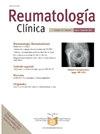Análisis situacional de la reumatología intervencionista en España: estudio observacional multicéntrico
IF 1.2
Q4 RHEUMATOLOGY
引用次数: 0
Abstract
Introduction
Interventional procedures are highly useful and applicable in rheumatology for degenerative and inflammatory diseases such a therapeutic alternative available for our patients.
Objective
To describe the current clinical characteristics of interventional procedures in rheumatology departments in our country and to identify the training needs in this area.
Material and methods
This is a multicenter, observational, descriptive, and cross-sectional study conducted through a survey sent to all heads of rheumatology departments/sections across the national territory, registered with the Spanish Society of Rheumatology.
Results
A total of 38 appropriately completed and valid surveys were received for analysis (56% of those sent). A percentage of 94.7 of the departments have one or more ultrasound machines, and 60.53% have a designated physical space specifically for performing procedures. A percentage of 97.73 perform joint injections, 31.58% perform sacroiliac joint injections, 21.05% perform lumbar facet injections, 15.79% perform myofascial injections, 13.16% perform epidural injections, and only 5.26% have access to radiofrequency therapy. Other procedures described were synovial biopsy (15.79%), salivary gland biopsy (10.53%), and isotopic synoviorthesis (7.89%). In 89.47% of the departments, the procedures are part of the rheumatology activities services, and 73.68% have nursing/auxiliary nursing support. Finally, 81.6% agree that there is insufficient specific training in performing more complex procedures.
Conclusion
The 21st-century rheumatologist must also be trained in performing interventional procedures for the treatment of mechanical and/or inflammatory pain, with the aim of incorporating them into their daily clinical practice and continuing to expand the range of care we can offer our patients.
西班牙介入性风湿病的现状分析:多中心观察研究
介入性手术在风湿病退行性和炎症性疾病中非常有用和适用,是我们患者的治疗选择。目的描述目前我国风湿病科介入手术的临床特点,确定该领域的培训需求。材料和方法这是一项多中心、观察性、描述性和横断面研究,通过向西班牙风湿病学会注册的全国所有风湿病部门/部门负责人发送调查进行。结果共收到38份正确填写并有效的问卷用于分析,占发送问卷的56%。94.7%的科室拥有一台或多台超声机,60.53%的科室拥有专门用于执行程序的指定物理空间。97.73%的患者接受过关节注射,31.58%的患者接受过骶髂关节注射,21.05%的患者接受过腰椎关节突注射,15.79%的患者接受过肌筋膜注射,13.16%的患者接受过硬膜外注射,只有5.26%的患者接受过射频治疗。其他手术包括滑膜活检(15.79%)、唾液腺活检(10.53%)和同位素滑膜穿刺(7.89%)。在89.47%的科室中,该程序是风湿病活动服务的一部分,73.68%的科室有护理/辅助护理支持。最后,81.6%的人认为在执行更复杂的程序方面缺乏专门的培训。21世纪的风湿病学家还必须接受介入治疗机械性和/或炎症性疼痛的培训,目的是将其纳入日常临床实践,并继续扩大我们可以为患者提供的护理范围。
本文章由计算机程序翻译,如有差异,请以英文原文为准。
求助全文
约1分钟内获得全文
求助全文
来源期刊

Reumatologia Clinica
RHEUMATOLOGY-
CiteScore
2.40
自引率
6.70%
发文量
105
审稿时长
54 days
期刊介绍:
Una gran revista para cubrir eficazmente las necesidades de conocimientos en una patología de etiología, expresividad clínica y tratamiento tan amplios. Además es La Publicación Oficial de la Sociedad Española de Reumatología y del Colegio Mexicano de Reumatología y está incluida en los más prestigiosos índices de referencia en medicina.
 求助内容:
求助内容: 应助结果提醒方式:
应助结果提醒方式:


